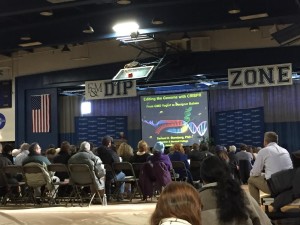By Izzy Schellenger || Staff Writer
In this week’s Common Hour, Sam H. Sternberg, Ph.D. presented his research surrounding the ethics and processes of genome editing. Sternberg earned his B.A. in biochemistry at Columbia University in 2007 and received his Ph.D. from the University of California, Berkeley, where he researched DNA-targeting with CRISPR and genome editing. In addition to his work’s publication and coverage in news outlets such as The New York Times and Science, Sternberg has presented his research internationally.

At the beginning of his speech, Sternberg showed a clip from the 1997 science fiction movie, Gattaca, in which future parents are able to select the sex, the physical characteristics, and the personality traits of their future child in order to create the “best” possible version. Even though these concepts seem far-fetched, Sternberg highlighted how many of these ideas have become a reality and are no longer science fiction. In 2013, two percent of all births in the United States were conceived through in vitro fertilization, a process where an egg is manually fertilized by sperm in a laboratory. In 2015, China began editing human embryos that could not be naturally implanted.
Sternberg’s research is centered on gene editing, which is the targeted modification of DNA inside living cells and organisms. Yogurt companies discovered repeating DNA sequences in yogurt bacteria called CRISPR, an acronym for Clustered Regularly Interspaced Short Palindromic Repeats. These repeating DNA sequences were hypothesized as a way to boost the immune system and to prevent viruses from spreading into cells. It was uncovered that CRISPR recognized “repeat offender viruses” from previously stored information, so CRISPR could prevent these repeat viruses from continuously affecting cells. Sternberg described CRISPR as a “molecular scissor machine” that targets and cuts DNA to separate the virus, making the cells and organisms immune to this virus.
CRISPR has worked to prevent viruses in many species, from mice and dogs to plants and fruits. This discovery led to the research surrounding genome editing. If the molecular components of CRISPR found in yogurt bacteria are transplanted into human DNA, the human genes could be edited as a way to improve the genome. Gene editing has been used as a basic research tool, which has lead to significant discoveries in understanding treatments for cancer, HIV, hemophilia, liver disease, and muscular dystrophy. While these uses of CRISPR are positive, Sternberg highlighted some controversial applications of gene editing. For example, CRISPR has been used to spread traits in the wild. In 2003, CRISPR was used to create a malaria-proof mosquito. Although the concept of this breakthrough seems promising, as malaria kills many people in Africa and South America every year, it is difficult to predict what would be the consequences of irreversibly releasing these traits into the wild. Another disputed use of CRISPR, Sternberg explained, is through the gene editing in plants and animals. Sternberg referred to pigs as his case study. In China, genetically modified pigs called micropigs are being sold as pets. Pigs are also being humanized so that their organs can be used for human organ transplants. Additionally, pig genomes are being modified to make them grow 20 percent more muscles, which would produce an improved source for human consumption.
Sternberg further described the types of gene editing that could be done on human genomes, making the clip he showed from Gattaca at the beginning of his lecture to be more fact than fiction. Somatic cells, which are all the cells in the human body that do not lead to reproduction such as nerve or muscle cells, can be edited in adults as a way to cure HIV positive patients. This type of gene editing would provide a single, month-long treatment for an otherwise permanent disease. Gene editing in germline cells, which are egg or sperm cells, can be used for disease prevention if both parents have a disease that could be passed on to their future children and it can be used for genetic enhancement. However, there are many arguments against the gene editing of germline cells because some view this as extremely unnatural and almost as if the scientist is “playing God.” Additionally, some see this as immoral because the future children who would be affected by this genome editing are not able to give their consent. Also, not everyone has access to CRISPR technology and the outcomes of gene editing can never be fully predicted.
Sternberg’s lecture was centered on the ethics behind gene editing. While some view this process as highly controversial, others see this as a huge step forward in the scientific community. Sternberg’s perspective is that we should all “follow our curiosity” about biology as a way to keep discovering, innovating, and changing the world. Few would have expected research on yogurt to go this far.
Sophomore Izzy Schellenger is a Staff Writer. Her email is crodrigu@fandm.edu.